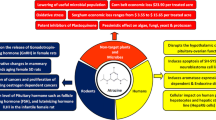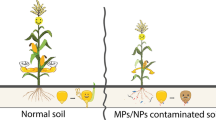Abstract
Mixed pollution is a characteristic of many industrial sites and constructed wetlands. Plants possessing an enzymatic detoxifying system that is able to handle xenobiotics seems to be a viable option for the removal of mixed persistent contaminants such organochlorines (OCs: monochlorobenzene (MCB), 1,4-dichlorobenzene (DCB), 1,2,4-trichlorobenzene (TCB), γ-hexachlorocyclohexane (HCH)). In this study, Phragmites australis plants were exposed to sub-lethal concentrations of OCs (7 days), in single-exposure (0.8 to 10 mg l−1) and in mixture of OCs (0.2 mg l−1 MCB + 0.2 mg l−1 DCB + 2.5 mg l−1 TCB + 0.175 mg l−1 HCH). Studies were conducted on the detoxification phase II enzymes; glutathione S-transferases (GST), and glucosyltransferases (UGT). Measurements of GST and UGT activities revealed that OCs may be buffered by glutathione and glucose conjugation. There appeared to be a correlation between the effects on phase II enzymes and the degree of chlorination of the benzene ring with, for example, the greatest effects being obtained for HCH exposure. In the case of mixed pollution, the induction of some GST isoenzymes (CDNB, 35 % non-significant) and UGT (118 %) in leaves and the inhibition of phase II enzymes in the other organs were measured. UGTs appear to be key enzymes in the detoxification of OCs.


Similar content being viewed by others
References
Adrian L, Szewzyk U, Wecke J, Gorisch H (2000) Bacterial dehalorespiration with chlorinated benzenes. Nature 408:580–583
Bakkali Y, Ruiz-Santaella JP, Osuna MD, Wagner J, Fischer AJ, De Prado R (2007) Late watergrass (Echinochloa phyllopogon): mechanisms involved in the resistance to fenoxaprop-p-ethyl. J Agric Food Chem 55:4052–4058
Biswas DK, Scannell G, Akhmetov N, Fitzpatrick D, Jansen MAK (2010) 2,4,6-Trichlorophenol mediated increases in extracellular peroxidase activity in three species of Lemnaceae. Aquat Toxicol 100:289–294
Braeckevelt M, Mirschel G, Wiessner A, Rueckert M, Reiche N, Vogt C, Schultz A, Paschke H, Kuschk P, Kaestner M (2008) Treatment of chlorobenzene-contaminated groundwater in a pilot-scale constructed wetland. Ecol Eng 33:45–53
Calabrese EJ, Baldwin LA (2002) Hormesis and high-risk groups. Regul Toxicol Pharmacol 35:414–428
Cherifi M, Raveton M, Picciocchi A, Ravanel P, Tissut M (2001) Atrazine metabolism in corn seedlings. Plant Physiol Biochem 39:665–672
Chopra AK, Sharma MK, Chamoli S (2011) Bioaccumulation of organochlorine pesticides in aquatic system-an overview. Environ Monit Assess 173:905–916
Cottin N, Merlin G (2010) Fate of chlorinated benzenes in laboratory peat and pozzolana filters. Water Air Soil Pollut 213:425–435
Fathepure BZ, Tiedje JM, Boyd SA (1988) Reductive dechlorination of hexachlorobenzene to trichlorobenzenes and dichlorobenzenes in anaerobic sewage-sludge. Appl Environ Microbiol 54:327–330
Faure M, San Miguel A, Ravanel P, Raveton M (2012) Dose responses to organochlorines in Phragmites australis. Environ Poll 164:188–194
Feidieker D, Kampfer P, Dott W (1995) Field-scale investigations on the biodegradation of chlorinated aromatic-compounds and HCH in the subsurface environment J Contam Hydrol 19:145–169
Gomez-Hermosillo C, Pardue JH, Reible DD (2006) Wetland plant uptake of desorption-resistant organic compounds from sediments. Environ Sci Technol 40:3229–3236
Hatzios KK, Burgos N (2004) Metabolism-based herbicide resistance: regulation by safeners. Weed Sci 52:454–467
Hertzberg RC, MacDonell MM (2002) Synergy and other ineffective mixture risk definitions. Sci Total Environ 288:31–42
Jansen MAK, Hill LM, Thorneley RNF (2004) A novel stress-acclimation response in Spirodela punctata (Lemnaceae): 2,4,6-trichlorophenol triggers an increase in the level of an extracellular peroxidase, capable of the oxidative dechlorination of this xenobiotic pollutant. Plant Cell Environ 27:603–613
Kaschl A, Schultz A, Vogt C, Dorusch F, Popp P, Borsdorf H, Kuster E, Kuschk P, Kastner M, Weiss H (2005) A meso-scale constructed wetland for the remediation of chlorobenzene contaminated groundwater. In: Thomson NR (ed) Bringing groundwater quality research to the watershed scale. IAHS Publication, Wallingford, pp 404–411
Kong FX, Hu W, Liu Y (1998) Molecular structure and biochemical toxicity of four halogeno-benzenes on the unicellular green alga Selenastrum capricornutum. Environ Exp Bot 40:105–111
Lal R, Pandey G, Sharma P, Kumari K, Malhotra S, Pandey R, Raina V, Kohler HPE, Holliger C, Jackson C, Oakeshott JG (2010) Biochemistry of microbial degradation of hexachlorocyclohexane and prospects for bioremediation. Microbiol Mol Biol Rev 74:58–80
Liu H, Weisman D, Ye YB, Cui B, Huang YH, Colon-Carmona A, Wang ZH (2009) An oxidative stress response to polycyclic aromatic hydrocarbon exposure is rapid and complex in Arabidopsis thaliana. Plant Sci 176:375–382
Lyubenova L, Gotz C, Golan-Goldhirsh A, Schröder P (2007) Direct effect of Cd on glutathione s-transferase and glutathione reductase from Calystegia sepium. Int J Phytoremediat 9:465–473
Lyubenova L, Schröder P (2011) Plants for waste water treatment—effects of heavy metals on the detoxification system of Typha latifolia. Bioresour Technol 102:996–1004
Ma XM, Burken JG (2002) VOCs fate and partitioning in vegetation: use of tree cores in groundwater analysis. Environ Sci Technol 36:4663–4668
Ma XM, Havelka MM (2009) Phytotoxicity of chlorinated benzenes to Typha angustifolia and Phragmites communis. Environ Toxicol 24:43–48
Magee KD, Michael A, Ullah H, Dutta SK (2008) Dechlorination of PCB in the presence of plant nitrate reductase. Environ Toxicol Pharmacol 25:144–147
Malcolm HM, Howe PD, Dobson S (2004) Chlorobenzenes other than hexachlorobenzene: environmental aspects. World Health Organization, Concise International Chemical Assessment Document, 60
Marcacci S, Raveton M, Ravanel P, Schwitzguebel JP (2006) Conjugation of atrazine in vetiver (Chrysopogon zizanioides Nash) grown in hydroponics. Environ Exp Bot 56:205–215
Marvin C, Painter S, Williams D, Richardson V, Rossmann R, Van Hoof P (2004) Spatial and temporal trends in surface water and sediment contamination in the Laurentian Great Lakes. Environ Pollut 129:131–144
Meharg AA, Wright J, Osborn D (2000) Chlorobenzenes in rivers draining industrial catchments. Sci Total Environ 251:243–253
Menone ML, Pflugmacher S (2005) Effects of 3-chlorobiphenyl on photosynthetic oxygen production, glutathione content and detoxication enzymes in the aquatic macrophyte Ceratophyllum demersum. Chemosphere 60:79–84
Michalowicz J, Urbanek H, Bukowska B, Duda W (2010) The effect of 2,4-dichlorophenol and pentachlorophenol on antioxidant system in the leaves of Phalaris arudinacea. Biol Plant 54:597–600
Miglioranza KSB, Sagrario M, de Moreno JEA, Moreno VJ, Escalante AH, Osterrieth ML (2002) Agricultural soil as a potential source of input of organochlorine pesticides into a nearby pond. Environ Sci Pollut Res 9:250–256
Miglioranza KSB, de Moreno JEA, Moreno VJ (2004) Organochlorine pesticides sequestered in the aquatic macrophyte Schoenoplectus californicus (C.A. Meyer) Sojak from a shallow lake in Argentina. Water Res 38:1765–1772
Monferran MV, Wunderlin DA, Nimptsch J, Pflugmacher S (2007) Biotransformation and antioxidant response in Ceratophyllum demersum experimentally exposed to 1,2- and 1,4-dichlorobenzene. Chemosphere 68:2073–2079
Petroutsos D, Wang J, Katapodis P, Kekos D, Sommerfeld M, Hu Q (2007) Toxicity and metabolism of p-chlorophenol in the marine microalga Tetraselmis marina. Aquat Toxicol 85:192–201
Petroutsos D, Katapodis P, Samiotaki M, Panavotou G, Kekos D (2008) Detoxification of 2,4-dichlorophenol by the marine microalga Tetraselmis marina. Phytochemistry 69:707–714
Pflugmacher S, Geissler K, Steinberg C (1999) Activity of phase I and phase II detoxication enzymes in different cormus parts of Phragmites australis. Ecotox Environ Safe 42:62–66
Ricking M, Schwarzbauer J (2008) HCH residues in point-source contaminated samples of the Teltow Canal in Berlin, Germany. Environ Chem Lett 6:83–89
San Miguel A, Ravanel P, Raveton M (2012a) A comparative study on the uptake and translocation of organochlorines by Phragmites australis. J Hazard Mater (in press)
San Miguel A, Faure M, Ravanel P, Raveton M (2012b) Biological responses of maize (Zea mays) plants exposed to chlorobenzenes. Case study of mono-, 1,4-dichloro- and 1,2,4-trichloro-benzenes. Ecotoxicology 21(2):315–324
Schröder P, Scheer CE, Diekmann F, Stampfl A (2007) How plants cope with foreign compounds—translocation of xenobiotic glutathione conjugates in roots of barley (Hordeum vulgare). Environ Sci Pollut Res 14:114–122
Schröder P, Lyubenova L, Huber C (2009) Do heavy metals and metalloids influence the detoxification of organic xenobiotics in plants? Environ Sci Pollut Res Int 16:795–804
Sinha S (2002) Oxidative stress induced by HCH in Hydrilla verticillata (l.f.) Royle: modulation in uptake and toxicity due to Fe. Chemosphere 46:281–288
Susarla S, Medina VF, McCutcheon SC (2002) Phytoremediation: an ecological solution to organic chemical contamination. Ecol Eng 18:647–658
Tawney I, Becker JG, Baldwin AH (2008) A novel dual-compartment, continuous-flow wetland microcosm to assess cis-dichloroethene removal from the rhizosphere. Int J Phytoremediat 10:455–471
Vernouillet G, Eullaffroy P, Lajeunesse A, Blaise C, Gagne F, Juneau P (2010) Toxic effects and bioaccumulation of carbamazepine evaluated by biomarkers measured in organisms of different trophic levels. Chemosphere 80:1062–1068
Vijgen J, Abhilash PC, Li YF, Lal R, Forter M, Torres J, Singh N, Yunus M, Tian CG, Schaffer A, Weber R (2011) Hexachlorocyclohexane (HCH) as new Stockholm Convention POPs-a global perspective on the management of Lindane and its waste isomers. Environ Sci Pollut Res 18:152–162
Vizcaino P, Pistocchi A (2010) A GIS model-based assessment of the environmental distribution of gamma-hexachlorocyclohexane in European soils and waters. Environ Poll 158(10):3017–3027
Zhang JY, Zhao W, Pan J, Qiu LM, Zhu YM (2005) Tissue-dependent distribution and accumulation of chlorobenzenes by vegetables in urban area. Environ Int 31:855–860
Acknowledgments
This work is part of VALORSITE-PHYCO project funded by AXELERA and supported by COST Action 859 for a Short-Term Scientific Mission (Helmholtz Zentrum München). We are especially grateful to Martha and John Willison for improving the English text.
Author information
Authors and Affiliations
Corresponding author
Additional information
Responsible editor: Philippe Garrigues
Rights and permissions
About this article
Cite this article
San Miguel, A., Schröder, P., Harpaintner, R. et al. Response of phase II detoxification enzymes in Phragmites australis plants exposed to organochlorines. Environ Sci Pollut Res 20, 3464–3471 (2013). https://doi.org/10.1007/s11356-012-1301-6
Received:
Accepted:
Published:
Issue Date:
DOI: https://doi.org/10.1007/s11356-012-1301-6




